Scanner-test report Reflecta ImageBox iR
The Reflecta ImageBox iR is the successor of the Reflecta ImageBox. It is a CMOS-scanner which photographs the original material by means of a kind of stational webcam instead of scanning it line by line, as it is normally the case in film scanners. The small name affix "iR" already gives a hint to the difference compared to the previous model:
The ImageBox iR has a dust and scratch correction based on an infrared technique for the use during the digitalization of slides and negatives. As it was already the case of the previous model, with the ImageBox iR it is also possible to scan paper images up to a size of 10x15 cm. But in this case, the automatic dust and scratch correction is not available.
Therewith, the new ImageBox IR offers the same range of functionaliy as the Reflecta MemoScan, but additionally, it can digitalize paper documents as the "old" ImageBox. Thus, it is practically possible to talk about a fusion of these two scanner models (Reflecta MemoScan and Reflecta ImageBox).
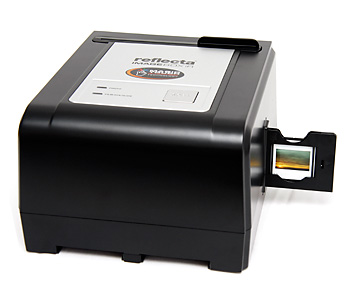
The exterior of the ImageBox iR does not differ from the one of the previous model, and also the interior has not changed except of the additional infrared technique. Therewith, the bad test results of the old ImageBox and the unsatisfactory results of the MagicTouch-technology of the MemoScan do not make it possible to expect much of the ImageBox iR.
But let's go step by step. The installation and the activation of the scanner was not a problem on our XP-computer: First, the provided software has to be installed. Beside the scan software CyberView CS, the image processing software Adobe® Photoshop® Elements is included in the scope of delivery but only in the old version 5.0. But considering the low price of the scanner, this is still a nice surplus, as a current version of the popular image processing software of Adobe® for the home user already costs about 100 euros. After all, this version is fully able to be updated, so that one can obtain the current version of Photoshop® Elements Version to a low price.
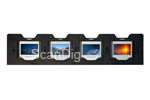
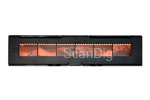
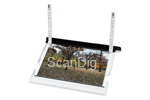
Moreover, there is also each a film adapter for up to four 35-mm slides and one for film strips up to a length of 6 images, an adapter for images up to a size of 10X15 cms and an USB cable included in the scope of delivery. This cable also provides electricity to the scanner so that a separate power supply is not needed.
Once everything is installed, one can start scanning. What is new is the option to access directly to CyberView CS, that means one does not have to start the Twain-driver anymore over the image processing programe but can operate it straight away over the start menue as a stand-alone appliance.
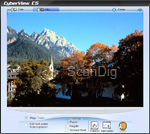
During the first start of CyberView, an automatic calibration of the light source takes place. Thereby, one has to make sure that there is no original document in the scanner - a thing that is clearly instructed in a message of a pop-up window. As it is the case in all CMOS-scanners of Reflecta, the scan software shows a life image of the picture captured by the sensor, of which a standing image in full resolution is transferred to the image processing programe and/or saved on the hard disc by a mouse click or by pressing the scan button on the top of the device. The software does not differ from the previous model in the handling and the MagicTouch-function that can be activated additionally.
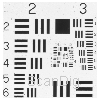
How is the image quality the ImageBox iR provides? Has it improved in comparison to the previous model, and does the dust and scratch correction work better than it was the case of the MemoScan? Therefore, we will first have a look to the USAF-test charts for the determination of the effectively achievable resolution. Here, the horizontal and the vertical lines of the element 4.5 can be barely distinguished, a thing that results in an effective resolution of just 1290 ppi. This is approximately 72% of the optical resolution announced by the producer of 1800 ppi. Therewith, the ImageBox iR is even positioned behind its previous model which still achieved 1450 ppit. By scanning a 35-mm slide or a 35-mm negative with the maximum nominal resolution of 18000 dpi, one obtains an image file with approximately 4,5 megapixels. But as the actual resolution is only of 1290 dpi, one effectively only obtains approximately 2,3 megapixels. This is very few, as today, the digital cameras for beginners are of 10 megapixels and more as a standard.
Concerning the range of density nothing has changed, the scans of the ImageBox iR barely show some drawing in the shades and the lights. In general, the scans rather appear blur and unsharp - the same case as in the "old" ImageBox.
Now we come to a feature that differs the ImageBox iR from its previous model: The dust and scratch correction for the scannings of slides or negatives. In the case of the Reflecta MemoScan, the results of the MagicTouch-technology were unfortunately not convincing at all. Maybe, things have changed in his concern.

And really: The dust and scratch correction works notably better than in case of the MemoScan. By clicking on the adjacent thumbnail, an image window opens that switches every three seconds between a scan with and a scan without MagicTouch. It is clearly visible: The majority of the dust grains are completely removed and there are also no image failures caused, a thing that is frequent in the case of low budget scanners with a dust and scratch correction. Here, the new ImageBox iR is clearly in advantage.
As otherwise only few things changed, in case of the ImageBox iR we come to a similar conclusion to the one of the ImageBox without this small name affix: Those who occasionally want to digitalize an image in a fast and easy way in order to, for example, send it via e-mail to friends, will be well off with the ImageBox iR. But for the high quality digitalization of image material, this device is not apt due to its rather bad image quality, even though the dust and scratch correction removes those ugly dust spots and scratches automatically.
More pictures and information are available in our test report of the Reflecta ImageBox, in which we get more in detail into the application and the operation of the scanner as also the handling of the scan software.
Back to the film scanner tests index
|